Massacre at Beziers. Catholics against the Cathars
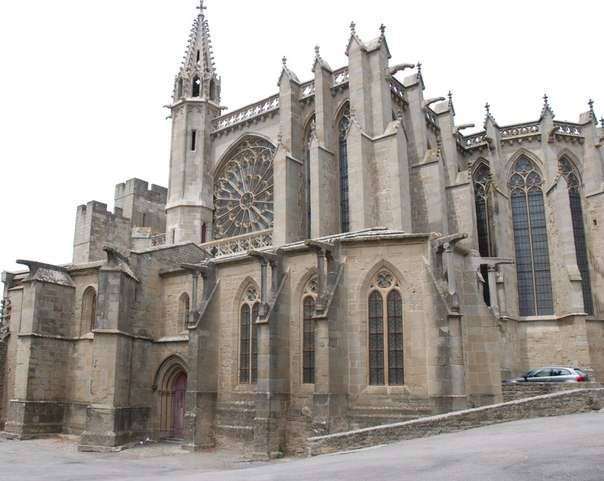
Cathedral of Saints Nazarius and Celsius in Carcassonne. These were local saints who were revered everywhere in the cities of the Languedoc.
LITTLE STORIES...
For the beginning, the preachers were sent, hoping to “rationalize” the apostates with the word of God. But apart from ridicule, the Roman papacy received nothing. Having failed, the church began to put pressure on the seniors of that region, Raymond (Raymund) V (1134 – 1194) and his heir Raymond (Raymund) VI (1156 – 1222), the counts of Toulouse, hoping to end the infidels with them.
Raymond VI was in no hurry to take action and assured the Pope of loyalty to the church dogma. Having survived public humiliation, he was forced to swear allegiance to the Catholic Church, although he could not and did not want to go against his own people.
Without waiting for the complete obedience of Raymond VI, Pope Innocent III (near 1161 - 1216) declared a crusade against the Cathars.
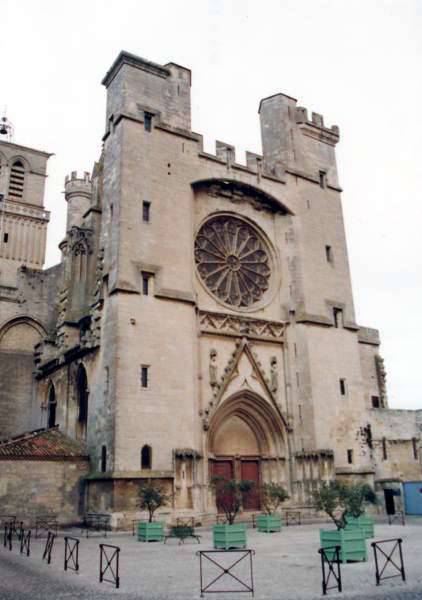
Cathedral of Saints Nazarius and Celsius in Beziers. The documents first mentioned the construction of the temple in the VIII century. The current church was built in the XIII century on the site of a former building that was destroyed in 1209 during a crusade against the Albigensians.
ARMY OF CROSSONS
King Philip II of France (1165 – 1223), together with his heir, did not want to lead the campaign against their own vassals, but allowed the Duke of Burgundy and Count de Nevers to take charge of the army of the Crusaders. The Burgundian aristocracy was distracted by the threat of rebellion and intrigues of the English king John (John) Landless (1166 – 1216) looming over Poitou, who had the support of German Kaiser Otton IV of Brunswick (1175 / 76 – 1218). Only 500 of the Burgundian Knights responded to the call. The army gathered in Lyon for the papal blessing was a very heterogeneous mass consisting of people of very different backgrounds.
The army also included 4000 sergeants in chain mail armor, or gober, up to the thigh, who followed the cavalry on foot. 400 crossbowmen were supposed to lead a "fire" battle. Their crossbows had the ability to release a thick and short boom at a distance of 300 m. They were arrested with a hook suspended from a belt, for which they hooked the string, inserting a leg into a loop or “stirrup” in front of the box and pushing it, i.e. leg, down. It was a very effective weapon against mail and shields. The Pope in the past twice forbade the use of crossbows against Christians, primarily because he allowed any peasant to kill the lord. And in this conflict both sides had crossbows.
RELIABLE BOTTOM ...
In the Catholic army, there was also a reserve: ribo-infantry, not trained in army discipline, a total of up to 5000 people armed with all sorts of, as a rule, very cheap weapons.
The presence of ribo in a military campaign was necessary for any medieval army. They were needed for household needs, because in addition to the soldiers who needed all sorts of services — from cooking to repairing shoes — there were also animals that needed to be grazed and looked after: they had to be fed, fed, picked. All this required a lot of people capable of doing this work. In exchange, simple food and shelter were offered. There were those who simply could not live without camp life, and therefore were ready to follow the army even to the ends of the earth.
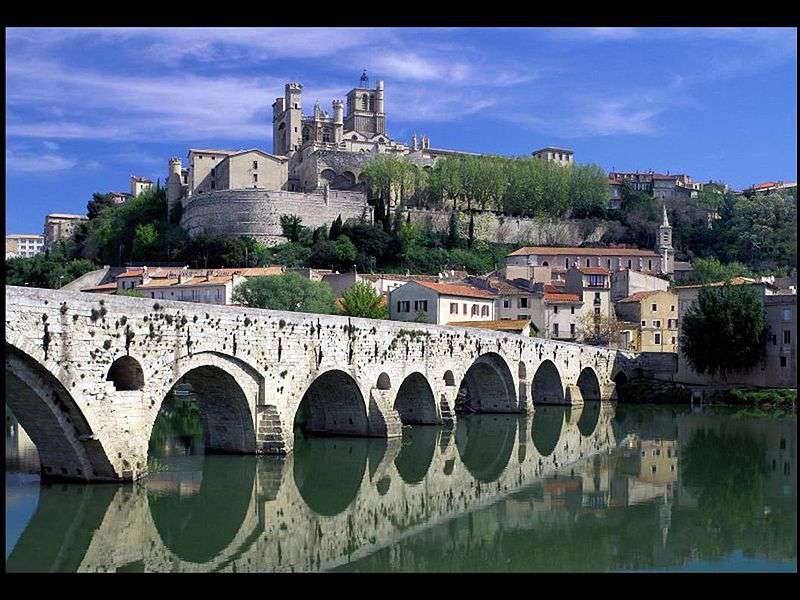
View of the city of Beziers and its cathedral.
The army's fellow travelers armed themselves as best they could, following, first of all, the capabilities of the wallet, as well as the acquired skills. Daggers and knives were the basis of the "gentleman's set." Ordinary clubs, swords and agricultural tools also had a place to be.
Let's not forget about the presence of squires in the 1000 army. Although, in truth, many of the knights had two assistants, and the service of squires, as a rule, did not reach.
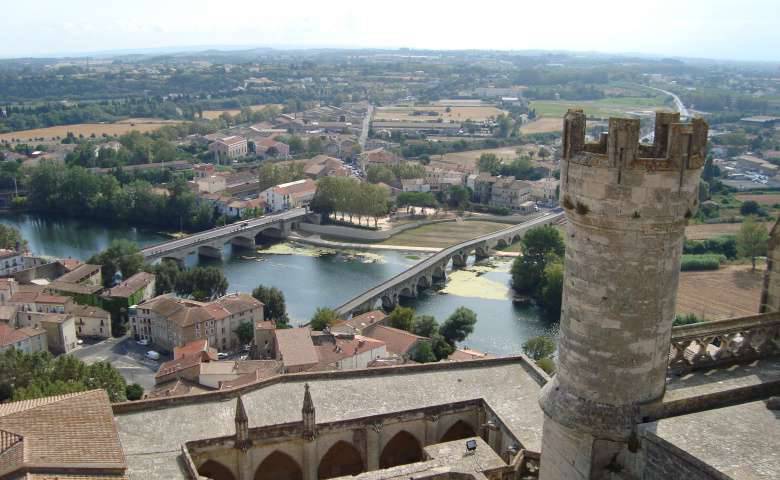
View of the Orb River and bridges over it from the roof of the cathedral. Of course, today everything has changed a lot here.
In addition, the siege train, consisting of dismantled catapults, kamnemetov, “cats” (a symbiosis of the house and a wagon with a reinforced roof and a ram suspended inside) and even siege towers, followed the campaign. Naturally, the mechanics of the train included mechanics and carpenters. The siege inventory floated down the Rhone on barges, and then set off in carts pulled by powerful oxen along the old Roman roads.
The administration of religious needs, as well as supervision of the spiritual purity of the medieval army, was carried out by several hundred clerics, headed by Arno Amory, Abbot Sito of the Cistercian monastery. The army consisted of 13 000 people, the same number of horses (fighting, race and dray), oxen and domestic animals, which were intended for the preparation of food from them. The army in the campaign stretched into a column about 10 km long.
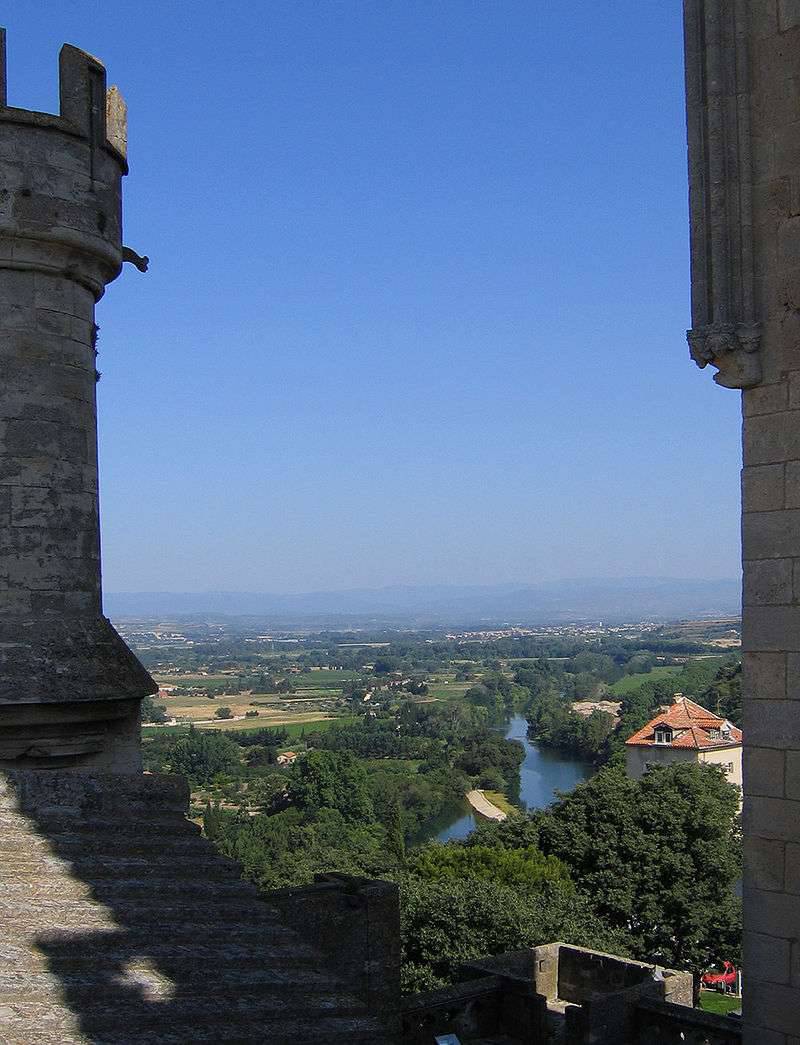
Another view from the roof of the cathedral to the side of the river, where the tents of the crusading army once stood.
A disgraced Raymond VI, Count of Toulouse, followed by vigilant surveillance by the clergymen, also followed the train. There was no evidence of what the count was doing during the fighting, but later he left the crusade army and stood at the head of the troops in defense of the Cathars.
CROSSOVERS AT THE WALLS OF THE CITY
Campaigners spent a whole month to reach Beziers, the first major city of the Cathars, located 250 km to the west. In Montpellier (a city located in 80 km before reaching Beziers), the viscount of the city of Raymond Roger Trankawel wished to join the ranks of the Crusaders, in order to avert suspicion from himself. Abbot Amory, however, categorically refused the services of the viscount. Unable to burn out the heresy in his own lot, he should have felt the consequences of conniving, and therefore should not have expected any mercy. Upon returning to the city, Raymond-Roger informed the citizens about the need to seriously prepare for defense, while he himself and the Jews went to Carcassonne in the hope of gathering an army and helping Beziers.
The townspeople, meanwhile, began to hastily store up provisions, water, and also to check and put in order the defensive powers: to clean and deepen the moat.
Here it is worth to tell a little about Bezier. The medieval city of Beziers was then located on the northern bank of the Orb River, not far from the beautiful, warm Mediterranean Sea. At one time, the Romans built a road here, calling it Via Domitia, which went through Spain, the south of France and Italy. A bridge about 300 m in length was built across the river, along which the inhabitants of Bezier could cross from the right bank of the river to the left and back all year round, despite the extensive floods of the river in winter.
The medieval city, reliably protected by powerful walls, stood on a rocky ledge, towering over the bridge at 20 m. This allowed the defenders of the city to keep in sight and in the area through the crossbows the near part of the bridge with 400 – 500 people. Below, under the walls, Faubre clung to the rock - a village with many houses and houses that did not fit inside the city perimeter. Direct assault on the bridge was inexpedient, because it promised great losses to the enemy, and the width of the river did not allow the use of catapults and stone throwers, since the stone shells simply did not reach the walls of Beziers.
PLAN LOCATION PLAN
The crusader army approached the city walls of July 21. Bishop Bezier, who followed along with the crusaders, persuaded residents to surrender the city.
In addition, the priest asked the army to issue heretics to 200 armies named after them, offering in return saved lives of their own. The request was indignantly rejected. The townspeople hoped for their defenders, for the strength and invulnerability of the city walls. And also on the fact that, not having achieved success, in a month, the enemy army itself will disperse to their homes.
The Crusaders, meanwhile, crossed the river and camped on a sandy platform south-west of the city. The distance from the city walls was sufficient to see the enemy in time and prevent a surprise attack. Ribo's simpler shelters were located closer to the bridge.
When the darkness began to dissipate, and dawn broke, a figure of a young man armed with a knife loomed on the bridge over the river.
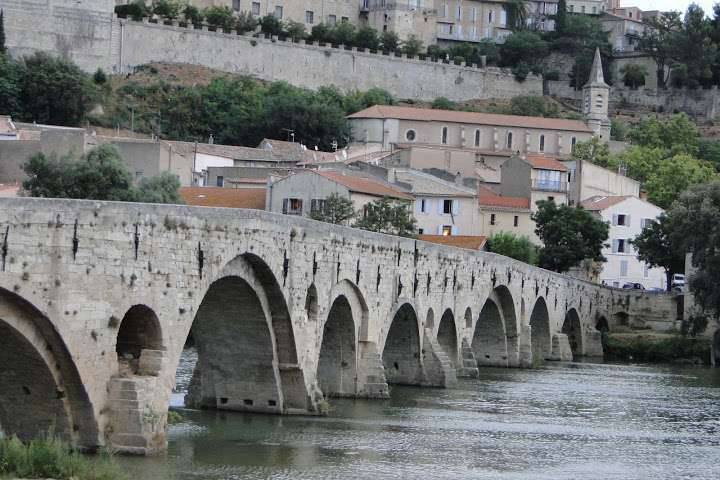
Here it is - this very bridge on which everything happened!
The purpose of his appearance on the bridge was incomprehensible: either bravado, or provocation, or he was simply drunk. Such courage did not promise anything good. A small detachment assembled in alarm, hastily left the city gates, and, having overtaken the young man, killed him.
It seemed, here it is, fortune! Fate itself gave the crusaders a chance to open the battle. A fight ensued between the ribo and the squad of city defenders. Defenders through Faubourg cramped back to the gate. The Crusaders rushed into battle, using the opportunity to try their luck and try to enter the city with the least loss. And the unfortunate townspeople hurried to repel the gates of the invaders. The battle moved to the narrow city streets. Everywhere cries of wounded and crying of children were heard. Men with weapons in their hands tried to fight off the attackers, fighting for their loved ones. However, the forces were unequal. Within a few hours, Beziers was ravaged, and many city dwellers found their death on the streets, and even in churches.
“BY GOOD INTENSIONS, THE ROAD TO HELL IS PUT”
The population of Beziers consisted mainly of Catholics, but Cathars were among the inhabitants. They lived, nevertheless, all amicably, peacefully, as befits respectable neighbors. Arno Amory, the abbot of the Cistercian monastery, was the one whom the Crusaders addressed with their questions. One of them sounded like this: “How can we distinguish Catholics from Cathars?”
In response, echoes of both Bible precepts sounded, and he himself became the property of history: “Kill everyone, God in heaven recognizes his own.”
And God's work began ... The entire population was destroyed, including those Catholics who hoped to find salvation at the altars of the Catholic churches. By noon, the works in the name of the Lord were completed, the city was deserted ... It cannot be said that for everything in the answer was one abbot Sieve with his carelessly abandoned phrase. 10 March 1208 Pope Innocent III, holding the council with Abbe Amory and 12 Cardinals, decided to "destroy and eradicate the Cathars ... from Montpellier to Bordeaux." In the next letter to the Pope, the abbot, with a feeling of "deep satisfaction" of the excellent work done, uttered: "Neither years, nor position, nor gender were their salvation." The exact number of victims of the massacre is not known until now. The numbers differ tenfold: from 7000 to 60 000 people, including, as they say, old men and babies.
Ribot, who took the city, and then massacred the inhabitants, looted the peaceful city of Beziers, taking away the amount of booty that they had never dreamed of in a dream. However, such insolent marauding infuriated the crusaders of the knights. Feeling left behind in the sharing of good, they decided to teach the “goloshtannyh” lesson, selecting the loot by force.
Ribot, not wanting to part with the loot, set fire to the city in retaliation. The fire was the apotheosis of this bloody orgy.
EPILOG
After Beziers, the crusade through the cities and villages continued. The warriors of Christ seized more and more new cities and castles, massacred heretics wherever they could. Thousands of them were burned. Frightened by the massacres in Beziers and, not wanting the same fate for themselves, the townspeople without resistance opened the gates of their cities. Rumors of presumptuous crusaders eventually reached the king of Aragon, who was forced to intervene and oppose the campaign in every possible way. Military operations were conducted, but not as actively as before. They faded out, then flared up, every time with varying success. 15 March 1244 of the year was a landmark day. Then the castle of Montsegur surrendered, after which, around 200, the proud and convinced Cathars of their faith were burned at the stake.
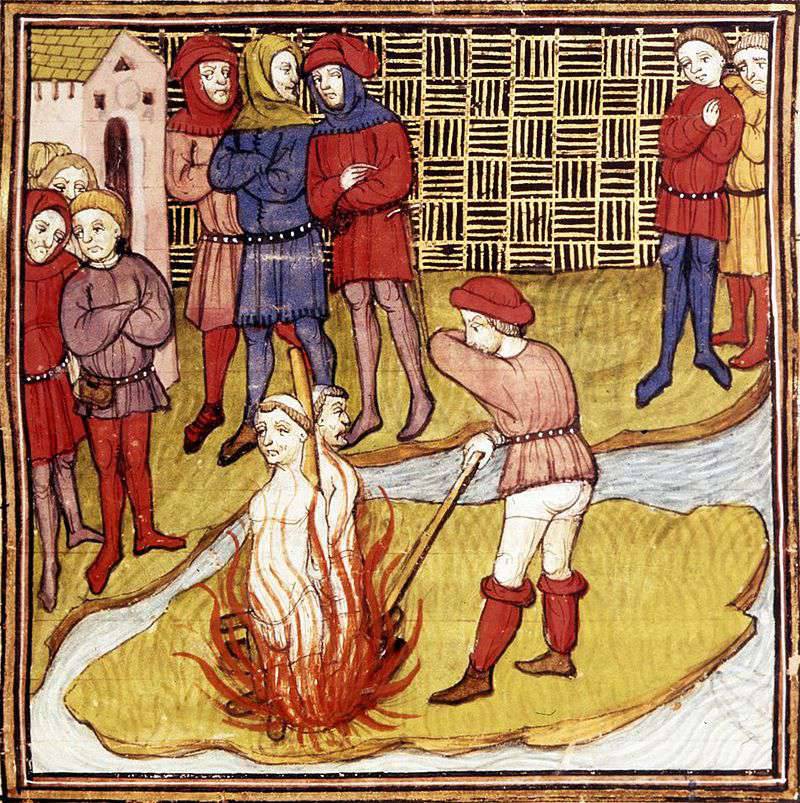
But the heretics burned! "Big Chronicle of France", about 1415, the British Library.
Another 35 years was the struggle of the Inquisition with the remnants of heresy, but did not put an end to them. In 1300, more than a dozen Cathar priests, or "perfect" ones, operating in Languedoc remained, the rest were forced to flee to Italy.
The French crown gradually took over most of the lands “liberated” from heresy. And although the Cathars were finally over, the Dominicans - the Catholic brotherhood officially recognized by the papacy - became followers of the ideals of the Cathars. Of course, not all, but those related to personal modesty and asceticism.
FORCES OF THE WARRIORS
CROSSONS (approximately)
Knights: 500
Horse Sergeants: 1000
Foot Sergeants: 4000
Crossbowmen: 400
Ribot: 5000
Total: 10900
CATARA (approximately)
City Guard: 3500
Unarmed civilian population: 30 000
Total: 33500
Information